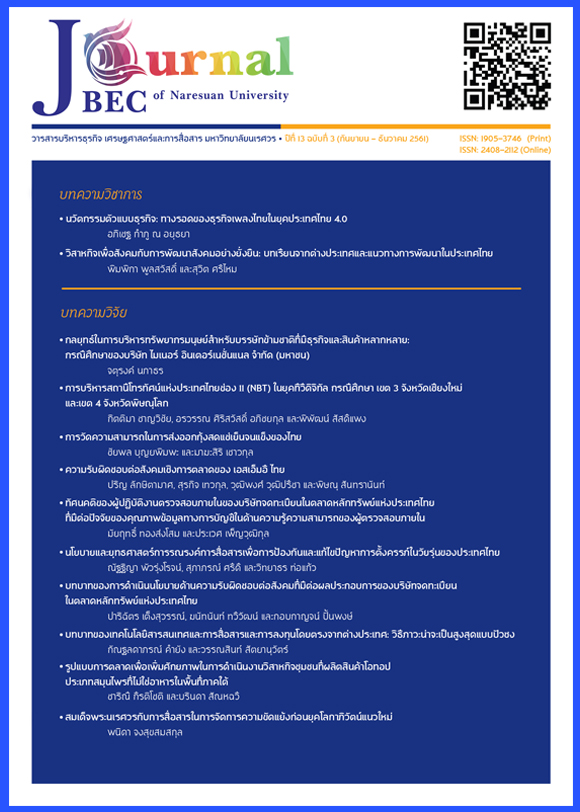The Social Marketing Responsibility of Thai SMEs
Main Article Content
Abstract
The research was aimed to study the social marketing responsibility of Thai entrepreneurs’ SMEs using the partial least squares path analysis. The research finding indicated that important factors in social marketing responsibility of Thai entrepreneurs’ SMEs in the consumer dimension had 17 indicators comprising 2 component factors including component factor (1) For consumer issues, corporations should concern about right and unbiased information, fair content practice, hygiene and safety for consumer protection for sustainable consumption (10 indicators); and component factor (2) Corporate should take consumer rights protection by distributing information and knowledge including increasing and awareness so that consumers understand about under standard products dangers from product consumption (7 indicators). Each factor had convergent validity because not only was the construct reliability of between 0.811-0.853 more than 0.60 but also the factor loading of between 0.408-0.733 was more than 0.40.
Article Details
References
2. Cronbach, L. J. (2003). Essential of psychology testing. New York: Hanpercollishes.
3. Department of Industrial Works. (2014). Guidelines for industrial entrepreneurs practices as standard measurement as CSR. Bangkok: Amarin Printing and Publishing.
4. Department of Industrial Works. (2015). Standard for corporate social responsibility. Bangkok: Amarin Printing and Publishing.
5. Department of Industrial Works. (2016). Cumulative number of factories allowed to operateunder the factory act 1992. Retrieved January 28, 2017, from https://www.diw.go.th/hawk/content.php?mode=spss59
6. Esteghamati, A., Zandieh, A., Khalilzadeh, O., Meysamie, A. and Ashraf, H. (2010). Clustering of metabolic syndrome components in a Middle Eastern diabetic and non-diabetic population. Diabetology and Metabolic Syndrome, 2(1), 36-43.
7. Green, T. and Peloza, J. (2011). How does corporate social responsibility createvalue for consumers. Journal of Consumer Marketing, 28(1), 48-56.
8. Hair, J. F., Anderson, R. E., Tatham, R. L. and Black, W. C. (2010). Multivariate data analysis. New Jersey: Prentice-Hall.
9. Hassan, L., Shaw, D., Shiu, E., Walsh, G. and Parry, S. (2013). Uncertainty in ethical consumer choice: A conceptual model. Journal of Consumer Behavior, 12(3), 182-193.
10. Hatcher, L. (1994). A step-by-step approach to using the SAS system for factor analysis and structural equation modeling. NC: SAS Institute.
11. Kim, Y. and Kim, S. Y. (2010). The influence of cultural values on perceptions of corporate social responsibility: Application of Hofstede’s dimensions to Korean public relations practitioners. Journal of Business Ethics, 91(4), 485-500.
12. Kultakormseat, N., Laksitamas, P. and Na Pathum, S. (2015). The structural equation model of causal factors influencing marketing strategies for fashion business of Thai garment towards the ASEAN economic community market. Journal of Business, Economics and Communications, 10(2), 145-156.
13. Martin, N. (2008). Development of a satisfaction survey analyzer using Partial Least Square Path Modeling (PLS-PM). Philosophy and Phenomenological Research, 76(3), 674-681.
14. Moosmayer, D. C. and Fuljahn, A. (2010). Consumer perceptions of cause relatedmarketing campaigns. Journal of Consumer Marketing, 27(6), 543-549.
15. Nonthanatorn, P. (2010). Corporate social responsibility management. Nonthaburi: Think Beyond Book.
16. Office of The Consumer Protection Board. (2015). Consumer information. Retrieved January 28, 2017, from https://www.ocpb.go.th/ewt_news.php?nid=36
17. Parina, P. And Matt, O. (2009). Research report on CSR development in Thailand and the volunteer role (translated). Bangkok: The Network for Sustainable Development Association.
18. Perez, A., Salmones, M. M. G. and Del Bosque, I. R. (2013). The effect of corporateassociations on consumer behavior. European Journal of Marketing, 47(1/2), 218-238.
19. Piriyakul, M. (27-28 May 2010). Partial Least Square path modeling (PLS Path Modeling). in Proceeding The 11th Statistics and Applied Statistics Conference (pp. 1-23). Holiday Inn Chiang Mai: Faculty of Science, Chiang Mai University.
2. Rodrigues, P. and Borges, A. P. (2015). Corporate social responsibility and its impact in consumer decision-making. Social ResponsibilityJournal, 11(4), 690-701.
21. Rovinelli, R. J. and Hambleton, R. K. (1977). On the use of content specialists in the assessment of criterion-referenced test item validity. Dutch Journal for Educational Research, 2(2), 49-60.
22. Social Business Institute. (2009). CSR definition. Retrieved January 27, 2017, from https://www.csri.or.th/knowledge/csr/193
23. Suwannawong, S. (2010). Introduction to statistics for the questionnaire. Retrieved January 24, 2017, from https://ruchareka.wordpress.com/2010/05/15/
24. Thailand Institute of Scientific and Technological Research. (2009). Social responsibility and ISO 26000 corporate social responsibility standard. Retrieved January 30, 2017, from https://www.tistr.or.th/tistr/csr/file/CSR2552.pdf
25. Thanomsiang, N. (2007). The quality of questionnaire. Khon Kaen: Statistics and demography department Khon Kaen University.
26. Thomson, S. K. (1992). Sampling. New York: John Wiley and Sons.
27. Tirakanan, S. (2007). Research methodology for social science: Implementation guide. Bangkok: Chulalongkorn University Printing.
28. Viratchai, N. (1999). The linear relationship (LISREL): Statistic for social science and behavioral sciences. Bangkok: Chulalongkorn University Printing.
29. Yammeesri, J. and Herath, S. K. (2010). Board characteristics and corporate value: Evidence from Thailand. Corporate Governance: The International Journal of Business in Society, 10(3), 279-292.


